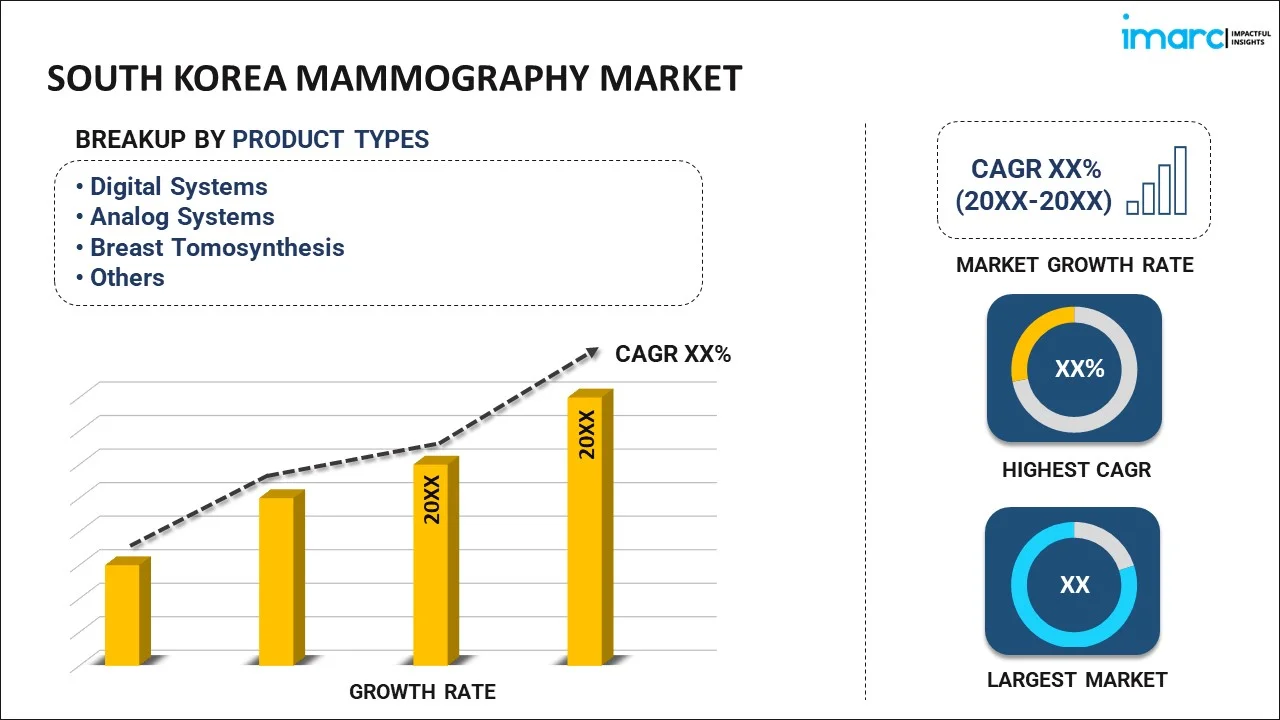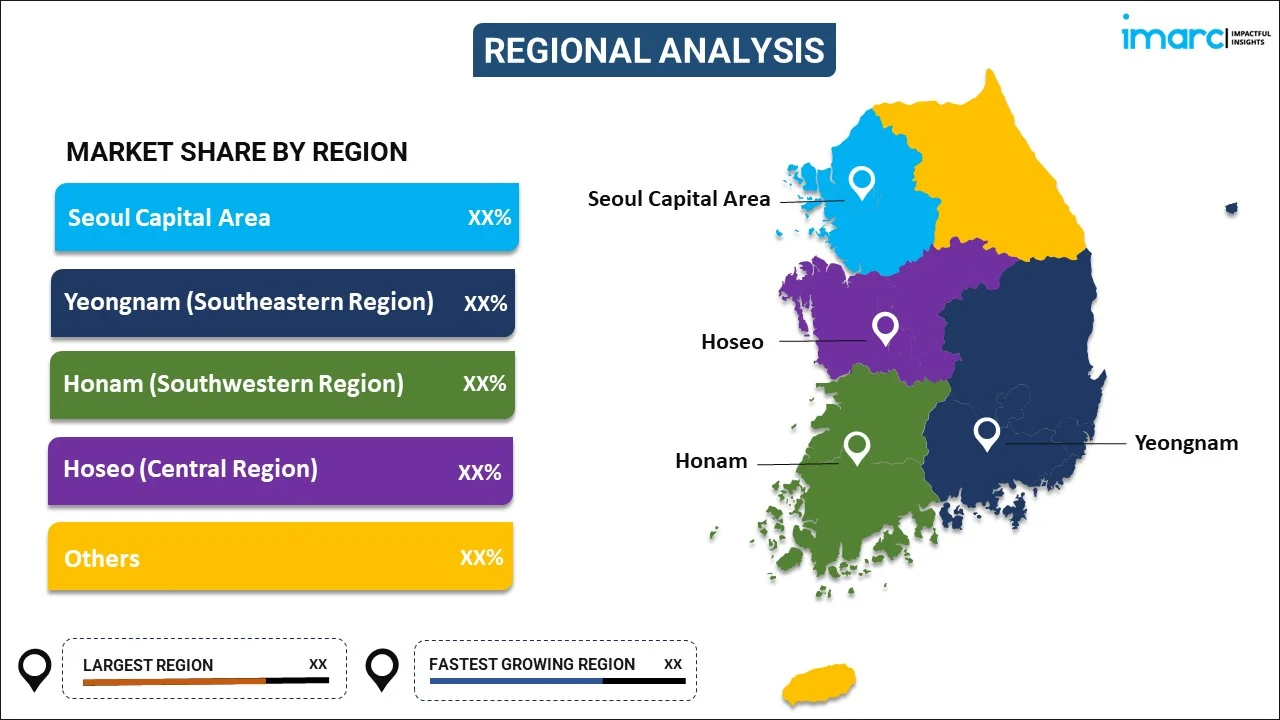
South Korea Mammography Market Report by Product Type (Digital Systems, Analog Systems, Breast Tomosynthesis, and Others), End User (Hospitals, Specialty Clinics, Diagnostic Centers), and Region 2024-2032
Market Overview:
South Korea mammography market size is projected to exhibit a growth rate (CAGR) of 9.7% during 2024-2032. The increasing breast cancer prevalence, significant technological advancements in mammography equipment, government support for healthcare initiatives, an aging population, and a growing trend in preventive healthcare practices represent some of the key factors driving the market.
|
Report Attribute
|
Key Statistics
|
|---|---|
|
Base Year
|
2023 |
|
Forecast Years
|
2024-2032
|
|
Historical Years
|
2018-2023
|
| Market Growth Rate (2024-2032) | 9.7% |
Mammography is a crucial medical imaging technique specifically designed for the early detection and diagnosis of breast cancer in women. This screening tool utilizes low-dose X-rays to capture detailed images of the breast tissue and identify abnormal changes, such as lumps or microcalcifications, that might indicate the presence of breast cancer. They are an essential component of breast cancer prevention and early intervention efforts because they can detect tumors long before they become palpable or cause noticeable symptoms. Mammography can be categorized into screening and diagnostic. Screening mammography is typically performed on asymptomatic women as part of routine breast cancer screening protocols, while diagnostic mammography is used when an individual presents with specific breast-related symptoms, such as pain, discharge, or changes in breast tissue. Mammography plays a crucial role in the early detection of breast cancer, leading to more successful treatment outcomes and improved survival rates, as it allows for the identification of malignancies at a stage when they are smaller, easier to treat, and less likely to have spread to other parts of the body.
South Korea Mammography Market Trends:
The increasing prevalence of breast cancer in South Korea, attributed to various factors, such as lifestyle changes, delayed childbearing, and obesity, has elevated the demand for mammography screening services, represents one of the key factors driving the market growth. Besides this, favorable government initiatives and public health campaigns promoting breast cancer awareness and early detection have further encouraged the adoption of mammography as a preventive healthcare measure, strengthening the market growth. Moreover, significant technological advancements in mammography equipment, such as the introduction of digital mammography and three-dimensional (3D) tomosynthesis with improved diagnostic accuracy and reduced false positives, enhancing the product appeal, are aiding in market expansion. In line with this, South Korea has a rapidly aging population, leading to an increased need for breast cancer screening among elderly women, as the risk of breast cancer rises with age, which is fueling the adoption of mammography services. Concurrently, greater access to healthcare services, including mammography facilities, in both urban and rural areas has further widened the reach of breast cancer screening, thereby supporting the market growth. In addition to this, the inflating income levels in South Korea have allowed more individuals to afford mammography services and breast cancer treatments, contributing to the market's growth. Furthermore, an increased focus on women's health and wellness has spurred interest in preventive healthcare practices, including regular mammography screenings, providing an impetus to the market growth. Apart from this, extensive collaborations between healthcare providers, research institutions, and medical equipment manufacturers have led to research and development (R&D) efforts to improve the accuracy and accessibility of mammography services, thus propelling the market forward across the country.
South Korea Mammography Market Segmentation:
IMARC Group provides an analysis of the key trends in each segment of the market, along with forecasts at the country level for 2024-2032. Our report has categorized the market based on product type and end user.
Product Type Insights:

- Digital Systems
- Analog Systems
- Breast Tomosynthesis
- Others
The report has provided a detailed breakup and analysis of the market based on the product type. This includes digital systems, analog systems, breast tomosynthesis, and others.
End User Insights:
- Hospitals
- Specialty Clinics
- Diagnostic Centers
A detailed breakup and analysis of the market based on the end user have also been provided in the report. This includes hospitals, specialty clinics, and diagnostic centers.
Regional Insights:

- Seoul Capital Area
- Yeongnam (Southeastern Region)
- Honam (Southwestern Region)
- Hoseo (Central Region)
- Others
The report has also provided a comprehensive analysis of all the major regional markets, which include Seoul Capital Area, Yeongnam (Southeastern Region), Honam (Southwestern Region), Hoseo (Central Region), and others.
Competitive Landscape:
The market research report has also provided a comprehensive analysis of the competitive landscape in the market. Competitive analysis such as market structure, key player positioning, top winning strategies, competitive dashboard, and company evaluation quadrant has been covered in the report. Also, detailed profiles of all major companies have been provided.
South Korea Mammography Market Report Coverage:
| Report Features | Details |
|---|---|
| Base Year of the Analysis | 2023 |
| Historical Period | 2018-2023 |
| Forecast Period | 2024-2032 |
| Units | US$ Million |
| Scope of the Report | Exploration of Historical and Forecast Trends, Industry Catalysts and Challenges, Segment-Wise Historical and Predictive Market Assessment:
|
| Product Types Covered | Digital Systems, Analog Systems, Breast Tomosynthesis, Others |
| End Users Covered | Hospitals, Specialty Clinics, Diagnostic Centers |
| Regions Covered | Seoul Capital Area, Yeongnam (Southeastern Region), Honam (Southwestern Region), Hoseo (Central Region), Others |
| Customization Scope | 10% Free Customization |
| Report Price and Purchase Option | Single User License: US$ 3699 Five User License: US$ 4699 Corporate License: US$ 5699 |
| Post-Sale Analyst Support | 10-12 Weeks |
| Delivery Format | PDF and Excel through Email (We can also provide the editable version of the report in PPT/Word format on special request) |
Key Questions Answered in This Report:
- How has the South Korea mammography market performed so far and how will it perform in the coming years?
- What has been the impact of COVID-19 on the South Korea mammography market?
- What is the breakup of the South Korea mammography market on the basis of product type?
- What is the breakup of the South Korea mammography market on the basis of end user?
- What are the various stages in the value chain of the South Korea mammography market?
- What are the key driving factors and challenges in the South Korea mammography?
- What is the structure of the South Korea mammography market and who are the key players?
- What is the degree of competition in the South Korea mammography market?
Key Benefits for Stakeholders:
- IMARC’s industry report offers a comprehensive quantitative analysis of various market segments, historical and current market trends, market forecasts, and dynamics of the South Korea mammography market from 2018-2032.
- The research report provides the latest information on the market drivers, challenges, and opportunities in the South Korea mammography market.
- Porter's five forces analysis assist stakeholders in assessing the impact of new entrants, competitive rivalry, supplier power, buyer power, and the threat of substitution. It helps stakeholders to analyze the level of competition within the South Korea mammography industry and its attractiveness.
- Competitive landscape allows stakeholders to understand their competitive environment and provides an insight into the current positions of key players in the market.
Need more help?
- Speak to our experienced analysts for insights on the current market scenarios.
- Include additional segments and countries to customize the report as per your requirement.
- Gain an unparalleled competitive advantage in your domain by understanding how to utilize the report and positively impacting your operations and revenue.
- For further assistance, please connect with our analysts.
 Inquire Before Buying
Inquire Before Buying
 Speak to an Analyst
Speak to an Analyst
 Request Brochure
Request Brochure
 Request Customization
Request Customization




.webp)




.webp)












